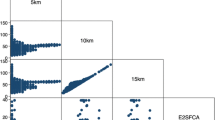Abstract
The objective of this study was to assess spatial accessibility (SA) to pediatric healthcare services at hospitals in Chiba Prefecture, Japan in 2006. We considered the distribution of general pediatricians and neonatologists relative to the geographical distribution of children using the two-step floating catchment area method, which accounts for the pediatrician-to-children ratios within catchment areas with defined travel distance (TD) thresholds. All measurements were carried out within a geographic information system. We found varied growth rate trends of children within the 61 municipalities of Chiba Prefecture between 1995 and 2006. The eastern and southern areas of the prefecture were less populated and had a small number of children in contrast to the central and northwestern areas, which had higher density of child population, less negative growth rates and even positive growth rate trends in some municipalities. For neonatology services, we used the number of live births (LB) and low birth weight (LBW) infants as populations. Lower LBW rates were found within the northern area while higher LBW rates were found within the southern area (minimum, 3.1%; maximum, 18.4%). The average LBW rate was 9.0% in Chiba Prefecture, whereas it was 9.5% for all Japan in 2005. SA analysis showed that 98.8% of children distributed within a 10 km TD threshold from a hospital with general pediatric services, and that 82.3% of LB and LBW distributed within a 30 km TD threshold from a hospital with neonatology services. The distribution of pediatricians relative to the population they serve was not homogeneous at local level. Through the methodology applied, we visualized areas short of pediatric services. The assessment of SA at local level provided informative results to achieve social equity in hospital access. The practical implications of this study are the need for reliable data for research purposes and policy development for children.






Similar content being viewed by others
References
Fujimura, M. (2005). How to secure the personnel for pediatric, and specifically neonatal, healthcare. Japan Medical Association Journal, 48(2), 99–106.
Hakui, T. (2005). Problems in medical care services for children. Japan Medical Association Journal, 48(9), 471–475.
Eto, Y. (2005). Pediatric health care in the 21st century. Japan Medical Association Journal, 48(6), 267.
Wada, N., et al. (2007). Current conditions of after-hours pediatric services and pediatricians’ overtime workloads in hospitals in Japan. The Journal of the Japan Pediatric Society, 111(7), 893–898.
Matsuo, N., Takayama, J. I., Takemura, K., & Kamoshita, S. (2005). Japanese national strategic plan for medical care and maternal and child health care. Japan Medical Association Journal, 48(6), 283–290.
Ding, H., Koinuma, N., Ito, M., & Nakamura, T. (2005). Strategies for improving pediatric services in Japan. The Tohoku Journal of Experimental Medicine, 206, 195–202.
Sakurai, Y., Moriwaki, K., Arakawa, H., Takada, E., & Tamura, M. (2006). How to deal with the increasing number of pediatric patients with acute illnesses during the night and holiday shift in University Hospitals in Japan-the status quo of the pediatric emergency in Saitama Medical Center and the future image of the Pediatric Department in University Hospitals. The Journal of the Japan Pediatric Society, 110(10), 1446–1449.
Umehara, K., Ohya, Y., Kawakami, N., Tsutsumi, A., & Fujimura, M. (2007). Association of work-related factors with psychosocial job stressors and psychosomatic symptoms among Japanese pediatricians. Journal of Occupational Health, 49, 467–481.
Luo, W., & Wang, F. (2003). Measures of spatial accessibility to health care in a GIS environment: Synthesis and a case study in the Chicago region. Environment and Planning B: Planning and Design, 30, 865–884.
Chiba Prefectural Government, population census. Available from: http://www.pref.chiba.jp/syozoku/b_toukei/nennreityouaza/index.html.
Statistics and Information Department, Minister’s Secretariat, Ministry of Health, Labour and Welfare. Health and Welfare Association (2005). Vital statistics of Japan (Vol. II, pp 44–45).
Statistics Bureau, Director-General for Policy Planning (Statistical Standards) & Statistical Research and Training Institute. Available from: http://stat.go.jp/index.htm.
Japan Map Center. JMC map (2003). Digital Map 2500 (Spatial Data Framework) CD-ROM, Kanto-2.
Micic, Z. (2004). Distance and accessibility measures calculation. Available from: l’Institut National de la Recherche Scientifique, Urbanisation Culture et Société, http://inrs-ucs.uquebec.ca/.
Matsuo, H. (2005). The health consequences of low birth weight: Literature review and critique. Institut de Démographie, les documents de travail, 23, 1–58.
Gluckman, P. D., Seng, C. Y., Fukuoka, H., Beedle, A. S., & Hanson, M. A. (2007). Low birthweight and subsequent obesity in Japan. The Lancet, 396, 1081–1082.
Tsukamoto, H., Fukuoka, H., Inoue, K., Koyasu, M., Nagai, Y., & Takimoto, H. (2007). Restricting weight gain during pregnancy in Japan: A controversial factor in reducing perinatal complications. European Journal of Obstetrics & Gynecology and Reproductive Biology, 133, 53–59.
Acknowledgments
This study was financially supported by a Grant-in-Aid from The Japanese Ministry of Education, Culture, Sports, Science and Technology (Monbukagakusho). F. Cervigni would like to thank the Department of Public Health, Graduate School of Medicine, Chiba University for support in the conduct of this research.
Author information
Authors and Affiliations
Corresponding author
Rights and permissions
About this article
Cite this article
Cervigni, F., Suzuki, Y., Ishii, T. et al. Spatial Accessibility to Pediatric Services. J Community Health 33, 444–448 (2008). https://doi.org/10.1007/s10900-008-9112-x
Published:
Issue Date:
DOI: https://doi.org/10.1007/s10900-008-9112-x




